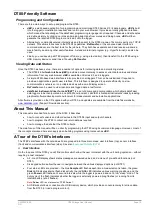
UM-0085-B09
DT80 Range User Manual
Page 22
RG
Measurements
What can the DT80 Measure?
Analog
Using its analog inputs, the DT80 can directly measure the following:
•
DC voltage
(30mV, 300mV, 3V , 50V, (30V – Series 3 or older) ranges)
•
DC current
(0.3mA, 3mA and 30mA ranges with internal 100 Ohm shunt)
•
resistance
(10Ω, 100Ω, 1kΩ, 10kΩ (maximum for Series 3 or older), 1MΩ ranges)
•
frequency
(0.1 to 450,000 Hz (to 10,000 Hz – Series 3 or older))
Many other quantities can be measured by connecting appropriate sensors which convert a physical quantity into
something that the DT80 can measure.
The DT80 directly supports:
•
4-20mA current loop
sensors (0 to 100%)
•
temperature
sensors (thermocouples, RTDs, thermistors, IC sensors)
•
bridges
and
strain gauges
•
vibrating wire strain gauges
(DT80G/ 85G only)
This list can be extended by means of user specified scaling calculations.
Digital
The DT80’s digital and counter channels allow the measurement of:
•
digital input state
(contact closure, CMOS or TTL logic)
•
pulse count
(32 bit)
•
phase encoder
position (32 bit)
Serial
Various “smart sensors” can also be read:
•
SDI-12
(Serial Data Interface – Programmable baud rates) based sensor networks
•
other
serial sensor
devices with an RS232/ 422/ 485 interface, such as weighing machines, barcode scanners
•
CAN
(Controller Area Network) sensors, using the optional dataTaker
CANgate
CAN to ASCII gateway device.
The use of this product is outside the scope of this manual.
Analog Channels – Introduction
Figure 2: DT80 analog terminals
Input Terminals
The DT80 provides five analog input channels, numbered 1 to 5. Depending on the wiring configuration used, these allow
between 5 and 15 separate voltages to be measured. The DT81 has one analog input channel, allowing 1-3 separate
voltages to be measured, and the DT82E has two (2-6 separate voltage measurements). Finally, the DT85 has 16
analog input channels, allowing 16-48 separate voltage measurements.
Each analog input channel on a DT80 is a 4-wire connection (see
) that allows voltage, current, resistance and
frequency to be measured. These are the fundamental signals output by most sensors. It is not necessary to use all four
terminals on each channel— two are often adequate.
Содержание DT80
Страница 29: ...UM 0085 B09 DT80 Range User Manual Page 29 RG The DT80 File System P114 ...
Страница 184: ...UM 0085 B09 DT80 Range User Manual Page 184 RG Figure 71 DT80 communications options ...
Страница 185: ...UM 0085 B09 DT80 Range User Manual Page 185 RG Figure 72 DT80 communications options integrated modem models ...
















































